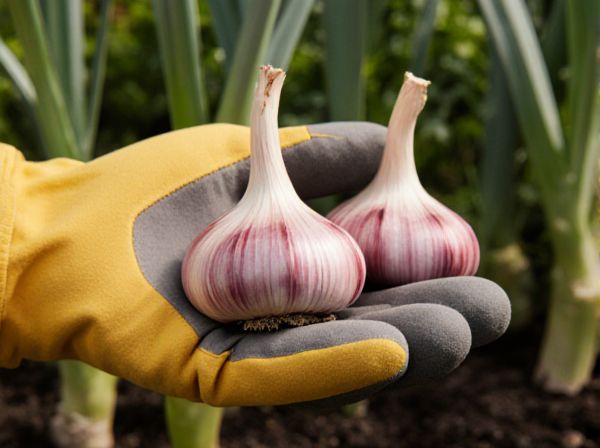
Garlic vs spider mite Illustration
Garlic acts as a natural repellent against spider mites due to its strong sulfur compounds, which disrupt the pests' feeding and breeding cycles. Planting garlic near susceptible plants can reduce spider mite populations and prevent infestations without harmful chemicals. This companion planting strategy promotes healthier growth and protects your garden organically.
Table of Comparison
| Aspect | Garlic | Spider Mite |
|---|---|---|
| Type | Allium sativum, a bulbous plant used as a companion crop | Tetranychidae family, tiny arachnid pest |
| Role in Gardening | Natural pest repellent, especially against spider mites | Destructive pest causing leaf damage and crop stress |
| Effect on Plants | Protects neighboring plants by repelling insects | Feeds on plant sap, leading to discoloration and reduced growth |
| Control Methods | Companion planting with vegetables, essential oils, extracts | Pesticides, biological control, and resistant plant varieties |
| Impact on Ecosystem | Eco-friendly pest management tool | Negative, damages plants and reduces yield |
Understanding Spider Mite Infestations in Gardens
Spider mite infestations in gardens are characterized by tiny, sap-sucking arachnids that cause leaf discoloration, webbing, and reduced plant vigor. Garlic acts as a natural companion plant due to its strong sulfur compounds, which repel spider mites and disrupt their reproduction. Integrating garlic into garden beds helps monitor and manage spider mite populations effectively, promoting healthier, pest-resistant plants.
Overview: Garlic as a Natural Pest Control
Garlic acts as a natural pest control by releasing sulfur compounds that repel spider mites and disrupt their feeding and reproduction. Its strong odor interferes with the mites' sensory organs, reducing infestations in companion planting setups. Using garlic extracts or interplanting garlic with susceptible crops creates an eco-friendly barrier against spider mite damage.
How Spider Mites Affect Plant Health
Spider mites damage plants by piercing leaf cells to extract sap, leading to stippling, yellowing, and premature leaf drop. Infested plants experience reduced photosynthesis, stunted growth, and increased vulnerability to diseases. Garlic acts as a natural repellent, emitting sulfur compounds that deter spider mite infestations and improve overall plant health.
Active Compounds in Garlic That Repel Spider Mites
Garlic contains sulfur compounds such as allicin, diallyl disulfide, and ajoene that exhibit strong repellent properties against spider mites. These bioactive compounds disrupt the nervous system of spider mites, reducing their feeding activity and reproduction rates. The natural pesticidal effect of garlic's essential oils offers an eco-friendly alternative for managing spider mite infestations in companion planting.
Preparing Garlic Spray for Spider Mite Management
Crushing 10 cloves of garlic and soaking them in 1 liter of water for 24 hours creates a potent garlic spray effective against spider mites. Strain the mixture and spray it directly onto affected plants, ensuring thorough coverage on the undersides of leaves where spider mites congregate. Regular application every 5 to 7 days helps disrupt spider mite activity and supports healthy plant growth without harmful chemicals.
Application Tips: Using Garlic Effectively Against Spider Mites
Garlic acts as a natural repellent against spider mites when applied as a spray made from crushed garlic cloves soaked in water for 24 hours, ensuring maximum extraction of allicin, the active compound. To enhance effectiveness, spray the garlic solution directly on the undersides of leaves where spider mites commonly reside, repeating application every 7-10 days to disrupt their life cycle. Combining garlic spray with regular garden hygiene and monitoring prevents spider mite infestations while minimizing reliance on chemical pesticides.
Comparing Garlic with Chemical Miticides
Garlic acts as a natural companion plant, releasing sulfur compounds that repel spider mites effectively without harmful residues, contrasting with chemical miticides that often contain synthetic pyrethroids or organophosphates. Unlike chemical treatments, garlic-based remedies reduce the risk of resistance development in spider mite populations and promote a healthier ecosystem by preserving beneficial insects. Integrating garlic as a biological control offers a sustainable alternative, minimizing environmental impact while maintaining effective spider mite management.
Pros and Cons of Garlic-Based Spider Mite Control
Garlic-based spider mite control offers natural pest repellent properties due to its sulfur compounds, which help deter spider mites without harmful chemicals. It provides eco-friendly benefits, reducing the risk of pesticide resistance and promoting soil health, though its effectiveness may vary with mite population density and environmental conditions. Frequent application is necessary to maintain protection, and it may irritate sensitive plants or beneficial insects if overused.
Success Stories: Gardeners Using Garlic Against Spider Mites
Gardeners report significant reductions in spider mite populations by applying garlic-based sprays, harnessing its natural acaricidal properties. Studies show that allicin, a sulfur compound in garlic, disrupts spider mite reproduction and feeding activity, leading to healthier plants. Success stories emphasize consistent garlic treatments combined with regular monitoring to maintain effective pest control.
Integrating Garlic Solutions into Organic Pest Management
In organic pest management, garlic serves as an effective natural repellent against spider mites due to its sulfur-containing compounds that disrupt mite feeding and reproduction. Integrating garlic solutions, such as garlic oil sprays or companion planting with garlic, enhances crop resilience while maintaining ecological balance. This approach reduces reliance on synthetic pesticides, promoting sustainable agriculture and supporting beneficial insect populations.
Garlic vs spider mite Infographic

 gardendif.com
gardendif.com